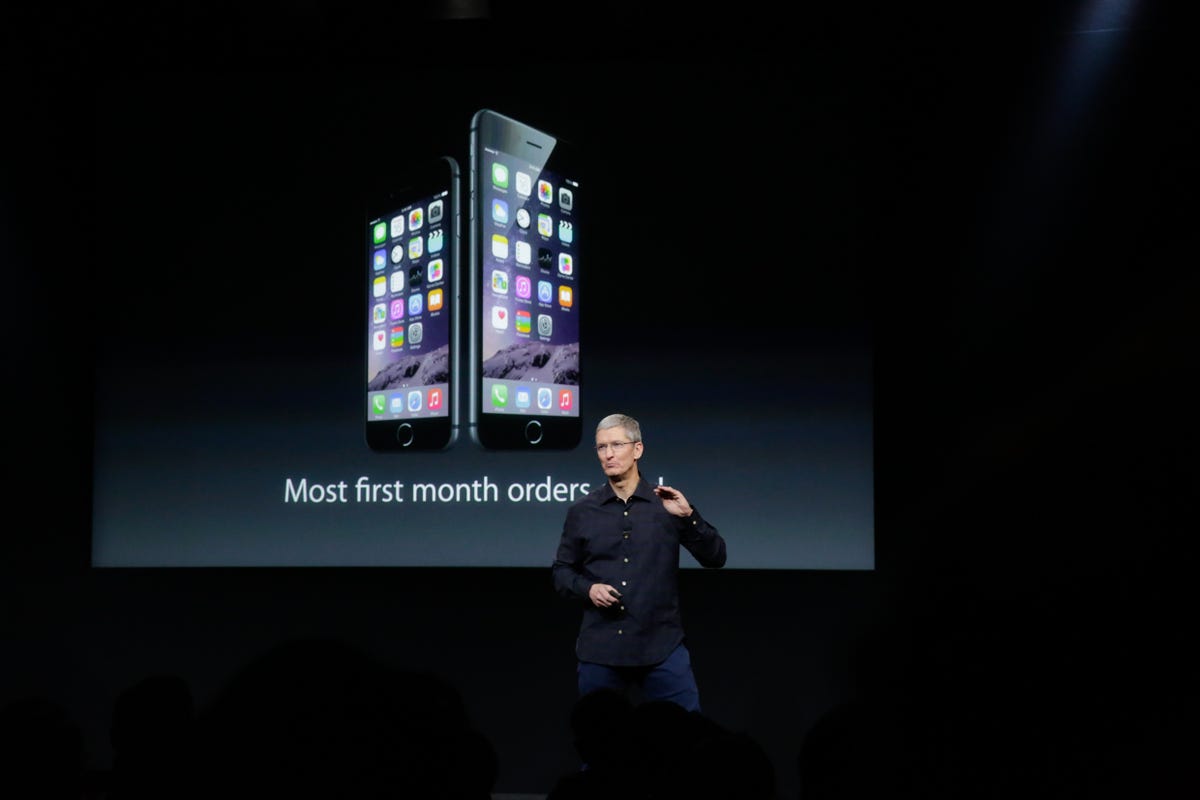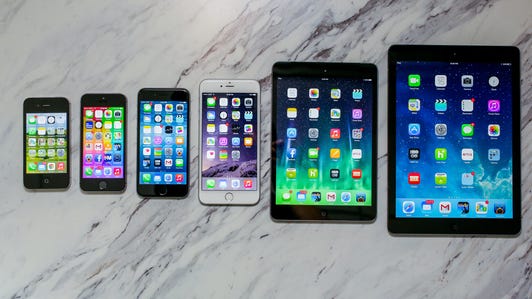
Tim Stevens/CNET
In the fiscal fourth quarter, almost more than any other, Apple showed that it’s still “the iPhone company.”
The Cupertino, Calif., electronics giant on Monday reported a blowout September quarter — largely thanks to strong smartphone demand. Sales and earnings in the quarter topped Wall Street expectations, as did iPhone shipments. Apple sold 39.3 million iPhones in the period, and the device made up 52 percent of its total revenue. Apple also projected stronger revenue for the holiday quarter than analysts anticipated.
See also
- CNET’s take on the iPad Air 2
- iPhone 6 promises happy holidays for Apple
- What Apple isn’t telling us anymore
- Apple, needing a jolt with new iPads, plays it safe instead
The only blot on the earnings sheet was iPad sales, which dropped for the third consecutive quarter and fell below revenue for Macintosh computers the first time in years.
For Apple, being the “iPhone company” comes with some big rewards but also some risks. Consumers are scooping up its newest smartphones in record numbers, but having one new iPhone that’s not a hit could hurt its financial results. iPad has long been the other strong product, but its sales have been waning in recent periods. That puts even more pressure on Apple to make sure it doesn’t have a miss in its iPhone line and that it expands its offerings into other areas.
The Apple Watch, expected early next year, will be its first new device since the iPad launched in 2010. And Apple Pay, the company’s mobile payments service available Monday, gives it a new services stream of revenue.
But for the foreseeable future, iPhone remains key to Apple’s financial performance. Here’s what Apple CEO Tim Cook had to say about the company’s newest smartphones and tablets:
iPhone 6 and 6 Plus are selling like crazy
Apple’s latest quarter included only about a week of iPhone 6 and 6 Plus sales, but the devices already gave the company a boost. Apple sold 39.3 million iPhones in the most recent period, up 16 percent from the year-ago period. Analysts, on average, had expected Apple to sell 37.8 million iPhones, according to a poll by Fortune. The company’s newest devices — the 4.7-inch iPhone 6 and the 5.5-inch iPhone 6 Plus — went on sale September 19, so Apple will get an even bigger boost from the products in the December quarter.
The new smartphones are currently shipping in 32 countries and will be in 69 countries by the end of October and 115 by the end of December. That makes the newest smartphones Apple’s “fastest and most successful iPhone launch ever,” Cook said. Demand is “staggering,” he said, and Apple can’t keep up with all the orders.
Here’s what else Cook had to say about iPhone, via a Thomson Reuters transcript.
The ramp itself is going great. It’s the fastest ever in our history. So I couldn’t be happier with it. That said, today, demand is far outstripping supply. It’s unclear, looking at the data when supply will catch up with demand. And so I don’t want to leave you with a view that we know that we’re going to get to a supply-demand balance on both of the new products this quarter because I don’t know that at this point.
It’s very difficult to gauge demand without first achieving — without first finding the balance. And it’s clear that as of today, and certainly as of the end of the quarter is where you’re looking at the data, we’re not nearly balanced. We’re not close. We’re not on the same planet…But that said, I’m really confident the supply’s going to be great and that’s the reason you see incredibly strong guidance [for the fiscal first quarter] that we’re giving from $63.5 billion and $66.5 billion.
But at this point it’s just very difficult to gauge what the true demand is. It’s very unusual to see every country having a marked improvement over the previous year. And that’s what we’re seeing on iPhone. And so I couldn’t be happier with the way the demand looks…
We’re selling everything we’re making and so essentially what our current sell through looks like is our current supply. And so in the long arc of time once there’s enough supply to meet demand, that mix [of iPhone 6 sales versus iPhone 6 plus] might look differently…I think that we will see a difference by geography in terms of preference, and we thought that going into the launch. And there’s no data that we’ve received to date that would suggest that, that’s not the case. And so that’s about all I can say at this point.
iPad still can’t get it together
Apple’s tablet has struggled for over a year, and there’s really no end in sight to the troubles. In the past six quarters, iPad sales have dropped or remained flat from the comparable period a year earlier. iPhone sales have never fallen year-over-year, even when the smartphone wasn’t as big an advance as hoped.
In the most recent quarter, Apple sold 12.3 million iPads, down 13 percent from a year earlier and below the 13.1 million units analysts had expected the company to sell, according to a poll by Fortune. The company hopes its newest iPads — the iPad Air 2 and the iPad Mini 3 — will help boost sales once they hit the market later this week.
Hands-on with the new Apple iPad Air 2 and iPad Mini 3 (pictures)






People are holding onto their iPads for much longer than their smartphones, and many are passing old models to friends and family. Cook acknowledged as much but said he still remains “bullish” about iPad’s future. And Financial Chief Luca Maestri touted different businesses and schools using the tablet.
At the same time, Apple’s Mac business has been surprisingly strong. In the fiscal fourth quarter, Apple shipped 5.5 million units, up 21 percent from a year ago. Cook noted sales were an all-time quarterly high for Macs, and Apple achieved its highest quarterly market share since 1995.
Here’s more on iPads, straight from Cook, via Thomson Reuters:
I’d take a step back on iPad. I know that there’s a lot of negative commentary in the markets on this, but I have a little different perspective on it. Here’s my simple perspective…Instead of looking at this thing each 90 days, if you back up and look at it, we’ve sold 237 million in just over four years. That’s about twice the number of iPhones that we sold over the first four years of iPhone.
If you look at the last 12 months of iPad, we sold 68 million. And FY13 we sold 71 million. So we were down, but we were down 4 percent on sell in and the sell-through was a bit better than the negative 4 percent because we took down channel inventory some. And so to me I view it as a speed bump, not a huge issue. That said, we want to grow. We don’t like negative numbers on these things.
And so looking further in the data, I know that there’s a popular view that the market is saturated, but we don’t see that. I can’t speak to other people, but I do look at our data deeply. And in the last market research data we have is in the June quarter.
Let me give you some of the real data that we’ve got. If you look at our top six revenue countries, in the country that’s sold the lowest percentage of iPads to people who had never bought an iPad before, that number is 50 percent. And the range goes from 50 percent to over 70 percent. And so when I look at first time buyer rates in that area…that’s not a saturated market. You never have first-time buyer rates at 50 percent and 70 percent.
What you do see is that people hold onto their iPad longer than they do a phone. And because we’ve only been in this business four years, we don’t really know what the upgrade cycle will be for people. And so that’s a difficult thing to call.
What we do know is that people always respond to do — for us doing great products and we feel really great about what we introduced last week.
We also know that the deeper the apps go in the enterprise, the more it opens up avenues in enterprise. And that’s a key part of the IBM partnership and what I think customers will get out of that, which is more important than us selling, is changing the way people work. And so I see catalysts going forward.
There are obvious cannibalization things that are occurring. I’m sure that some people looked at a Mac and an iPad and decided on a Mac. I don’t have research to demonstrate that, but I’m sure of that just looking at the numbers. And I’m fine with that, by the way. I’m sure that some people will look at an iPad and an iPhone and decide just to get an iPhone and I’m fine with that as well.
But over the long arc of time, my own judgment is that iPad has a great future. How the individual 90 day clicks work out, I don’t know. But I’m very bullish on where we can take iPad over time, and so we’re continuing to invest in the product pipeline. We’re continuing to invest in distribution.
The iPhone 6 and iPhone 6 Plus face off against the competition (pictures)









